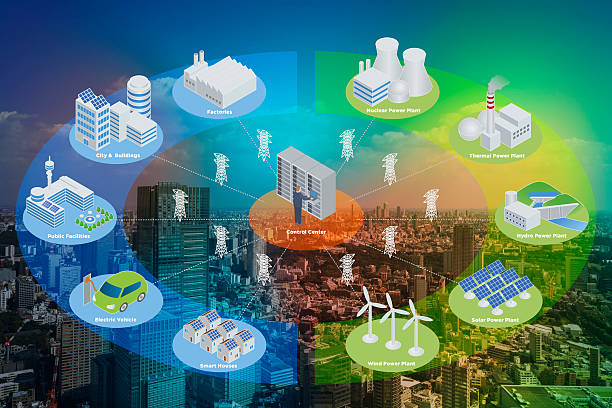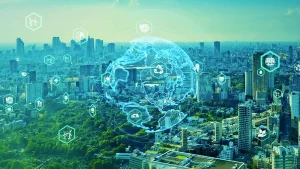One of the most important issues of our day is climate change, which poses serious risks to ecosystems, human health, and global economies. Technology becomes a vital friend as we work to lessen its effects and make the shift to a more sustainable future. We have strong tools at our disposal thanks to technology, from cutting-edge data analytics to innovative renewable energy. We shall examine the many facets of technology’s contribution to solving this worldwide emergency in this blog article, emphasising significant advancements and their possible effects on the environment.
Smart Grids and Energy Management
Smart Grids
 Smart grid technology is transforming the way electricity is generated, distributed, and consumed. Unlike traditional grids, smart grids use digital communication and automation to optimize the flow of electricity, integrate renewable energy sources, and respond dynamically to changes in demand. For businesses, implementing smart grid technology can lead to significant cost savings and improved operational efficiency. By using real-time data and advanced analytics, smart grids can reduce energy waste, improve efficiency, and enhance grid resilience.
Smart grid technology is transforming the way electricity is generated, distributed, and consumed. Unlike traditional grids, smart grids use digital communication and automation to optimize the flow of electricity, integrate renewable energy sources, and respond dynamically to changes in demand. For businesses, implementing smart grid technology can lead to significant cost savings and improved operational efficiency. By using real-time data and advanced analytics, smart grids can reduce energy waste, improve efficiency, and enhance grid resilience.
Demand Response
Demand response programs incentivize consumers to reduce or shift their electricity usage during peak demand periods. Businesses can participate in these programs by installing smart meters and connected devices to enable real-time monitoring and management of energy consumption. This not only helps prevent blackouts but also reduces the need for fossil fuel-powered peaking plants, thereby lowering emissions and saving on energy costs.
Energy Efficiency Technologies
 Building Automation
Building Automation
Building automation systems (BAS) use sensors, controllers, and software to optimize the operation of heating, ventilation, and air conditioning (HVAC) systems, lighting, and other building systems. By adjusting settings based on occupancy, weather conditions, and other factors, BAS can significantly reduce energy consumption. For businesses, this translates to lower utility bills and a smaller carbon footprint. Advanced BAS can also integrate renewable energy sources and energy storage, further enhancing efficiency and sustainability.
Energy-Efficient Appliances
The development of energy-efficient appliances has contributed to substantial reductions in household and commercial energy use. Innovations in materials, design, and technology have led to the creation of appliances that consume significantly less energy than their predecessors. Businesses can benefit from investing in energy-efficient appliances, such as LED lighting, energy-efficient HVAC systems, and modern office equipment. These investments not only reduce operational costs but also demonstrate a commitment to sustainability, which can enhance a company’s brand image and appeal to environmentally conscious consumers and partners.
Transportation Innovations
Electric Vehicles (EVs)
Electric vehicles are at the forefront of the transition to sustainable transportation. Advances in battery technology have improved the range, performance, and affordability of EVs, making them a

viable alternative to internal combustion engine vehicles. Businesses can benefit from adopting EVs for their fleets, reducing fuel costs, and lowering their carbon footprint. Additionally, the
development of fast-charging infrastructure and the integration of renewable energy sources into charging stations are enhancing the environmental benefits of EVs.
Public Transportation and Logistics
Technological improvements are also helping public transport networks. Public transport is becoming more eco-friendly, dependable, and efficient with the electrification of buses, trains, and trams as well as the installation of smart ticketing and real-time tracking systems. Telematics and route optimisation software are two tools that logistics companies can use to cut down on emissions and fuel usage. Because autonomous cars and ride-sharing services optimise routes and decrease the number of vehicles on the road, they also help to lower the transportation sector’s carbon footprint.
Technology Integration in Business Operations
Cloud Computing
Cloud computing offers businesses the ability to reduce their carbon footprint by minimizing the need for physical servers and data centers. Cloud providers often use energy-efficient infrastructure and renewable energy sources to power their operations. By migrating to the cloud, businesses can improve their energy efficiency, reduce electronic waste, and benefit from scalable, cost-effective computing resources.
Data Analytics
Advanced data analytics enables businesses to monitor and optimize their energy usage, track emissions, and identify areas for improvement. Predictive analytics can forecast energy demand, allowing businesses to implement energy-saving measures proactively. By leveraging big data, businesses can make informed decisions that align with their sustainability goals and improve operational efficiency.
Internet of Things (IoT)
The Internet of Things (IoT) connects devices and systems, allowing for real-time monitoring and control of energy usage, equipment performance, and environmental conditions. Businesses can use IoT solutions to optimize their energy consumption, automate energy-saving measures, and reduce waste. For example, smart thermostats, lighting systems, and machinery can adjust their operation based on occupancy, time of day, or environmental factors, leading to significant energy savings.
Remote Work and Telecommuting
The COVID-19 pandemic accelerated the adoption of remote work and telecommuting, demonstrating that many businesses can operate effectively without a physical office presence. By continuing to support remote work, businesses can reduce their carbon footprint by decreasing the need for commuting and office energy consumption. Investing in reliable IT infrastructure and collaboration tools can make remote work a sustainable long-term option.
Sustainable Supply Chain Management
Technology can also play a crucial role in making supply chains more sustainable. Blockchain technology, for instance, can provide transparency and traceability, ensuring that products are sourced and produced in environmentally friendly ways. Businesses can use logistics software to optimize routes and reduce transportation emissions. Additionally, implementing digital twins—virtual replicas of physical assets—can help businesses model and improve their supply chain operations for better efficiency and sustainability.
Conclusion
The role of technology in combating climate change is both vast and vital. From renewable energy innovations to smart grid technologies, energy-efficient appliances, and advanced transportation solutions, technology provides businesses with the tools needed to reduce their carbon footprint and contribute to a sustainable future. By integrating these technologies into their operations, businesses can not only achieve significant cost savings and operational efficiencies but also demonstrate their commitment to environmental stewardship.
Embracing technology for climate action is not just a moral imperative; it also offers a competitive advantage. Companies that lead the way in sustainability are likely to attract environmentally conscious customers, investors, and partners. Moreover, they will be better positioned to comply with emerging regulations and standards aimed at reducing carbon emissions.
As we look to the future, the continued development and deployment of innovative technologies will be essential in our fight against climate change. Businesses have a critical role to play in this endeavor, and by leveraging technology, they can make a substantial impact on our planet’s health and sustainability.

